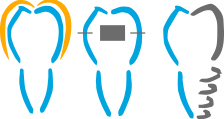Orthodontics
Orthodontics deals with the treatment of tooth irregularity and disproportionate jaw relationships. People come to orthodontic treatments primarily because of tooth irregularity. However, it is important to take account of the long-term functioning and health of the teeth. Dental displacment can lead to problems with chewing, speaking, and phonation, or mandibular joint complaints can occur, etc. While those teeth that are irregularly aligned are more difficult to clean, cavity is more likely to appear. In contrast with this, the grooming of normal dention is much easier. While earlier only children, teenagers, or young adults took part in orthodontic treatments, today also middle-aged and even elder patients apply for these treatments.
Pediatric orthodontics: Pediatric orthodontics aims to help the teeth and jaw develop in the correct direction.
- Early treatments at the age of 6-12 when the milk teeth and permanent teeth are both present in the mouth, the treatment is made with a removable orthodontic appliance.
- Adolescent treatment at the age of 12 to 18, in case of permanent teeth it is made with a fixed device.
Adult orthodontics At any age it is possible to move the teeth, if the condition of the bone and gum surrounding the teeth allows it. Bone tissue is extremely adaptable (relocatable), which allows the movement of teeth and their attachment to a new place. In adulthood fixed and cemented devices are used.
Types of devices
- Removable appliances
- passive equipment in case of early tooth loss they help keeping the space for permanent teeth
- active removable plates used to dilate tooth arch and move certain teeth
- functional appliances they control the growth of the jaws in the right direction by which malocclusion can be corrected preventing later operations
- Fixed appliances
- traditional appliance metal or aesthetic (ceramic) devices. In case of these types, the archwire is attached to the brackets with small rubber bands.
- self-ligating (self-closing) devices These devices fix the archwires with the help of their own lock (soft orthodontics). They are low-friction metal bracket systems that exist in metal and aesthetic design as well. This includes the Damon system.
Additional tools
- elastic rubber bands By placing rubber bands on the fixed orthodontic appliances we can correct the bite, fine-tune the jaw junctions and move certain teeth or groups of teeth.
- artificial bite correction we use it on front or back teeth for faster and more efficient tooth movement in order to avoind the teeth getting in contact with the brackets (locks).
- orthodontics with mini-implants it is used when there is not enough support for tooth movement or if we would like to avoid the unwanted side effects
Retainers - to keep teeth in place once braces are removed
- fixed retainer a passive wire bonded to the tongue-side of the teeth
- removable retainer (deep-drawn) a removable transparent plastic device
- removable plate passive version of removable orthodontic appliance


